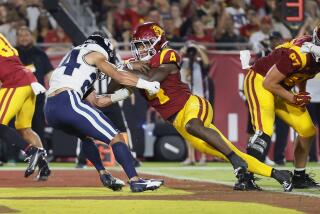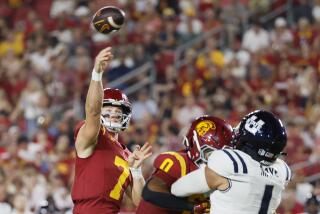Zamperini the Most Authentic Hero in USC Lore
There was a time when they were the only game in town. Our only national figures. There was Chaplin, Pickford, Fairbanks--and the USC Trojans.
They were larger than life--great, golden hunks of muscle right off the beaches of Santa Monica, and they could do anything. Run the hundred, throw the discus, beat Notre Dame, win the Rose Bowl, bring back the Davis Cup, take over the Olympics. Whatever you did on the playing field, they did better. They were the darlings of the movie crowd. John Wayne came off a Trojan football field. So did about half the producers, directors, cutters and gofers of the industry.
For the record:
12:00 a.m. Dec. 20, 1991 For the Record
Los Angeles Times Friday December 20, 1991 Home Edition Sports Part C Page 9 Column 1 Sports Desk 2 inches; 38 words Type of Material: Correction
Louis Zamperini--Thursdayâs editions incorrectly reported that he set an NCAA mile record when he was 17. Zamperini set a high school mile record at 17, while he was at Torrance High. He set his NCAA mile record of 4 minutes 8.3 seconds when he was older, running for USC in 1938.
Their football team was known as the Thundering Herd, their baseball team became next yearâs St. Louis Cardinals, their track teams won more gold medals than some countries.
Everybody knew their names. There was Cotton Warburton, the Musick brothers, Aaron Rosenberg, Garrett Arbelbide, Racehorse Saunders, Marshall Duffield, Gaius Shaver and on and on. Great names, great players. The sports world feared them.
But you know who may have been the noblest Trojan of them all?
He never won a Heisman. He finished eighth in his only Olympics. He couldnât hit the curveball, but he is the most authentic hero Troy ever loosed on society. His career defines the U.S. mid-century as few who survived it could.
How about, for openers, climbing a fence in Hitlerâs Berlin Chancellory and stealing a flag? Der Fuehrerâs own? Amid gunfire?
How about setting an NCAA record in the mile at age 17, then going to the Olympics as a 5,000-meter runner after practicing the event only for a few weeks and beating world record-holder Don Lash?
But thatâs kid stuff. How about becoming the bombardier on the B-24 that knocked out the Japanese airfield on Wake Island and made the subsequent landing a, so to say, day at the beach for the Marines? How about being on a daylight bombing run over enemy-held Nauru in which Japanese Zeroes attacked, shot out the rudders, knocked out the hydraulic system and put 500 bullet holes and cannon fragments through his plane? How about struggling with bomb bay doors, which were impossible to close, in order to rescue a radio operator who was hanging by his fingertips to an open bomb door 10,000 feet over shark-infested waters? How about crash-landing back on return to base with an all but demolished aircraft, thus becoming one of the original inspirations for the wartime song âComing-In-On-A-Wing-And-A- Prayerâ?
How about crashing in the Pacific on a rescue mission to save a downed B-25 flier and then spending 47 days adrift in a life raft with holes in it (where passing Japanese planes strafed it)? How about eating raw shark and albatross to stay alive, praying daily for rain to drink, fighting predatory sharks with your bare hands?
How about the longest raft drift in the annals of World War II (Rickenbackerâs celebrated drift was 27 days), and hitting land weighing 60 pounds, only to find it in Japanese hands? How about being thrown into prisoner-of-war camps and being beaten repeatedly for refusing to make propaganda broadcasts for the enemy?
How about spending 2 1/2 years in solitary confinement in a hole in the ground 7 feet deep, 2 1/2 feet wide and 7 feet long, a cemetery of the spirit?
All of the above happened to Louis Zamperini. It wasnât a John Wayne movie, it wasnât a Batman comic book, it was, so to say, a documentary--his documentary.
The Hitler incident came after Zamperini had met Der Fuehrer in the dictatorâs box at Berlin in 1936. Zamperini had just run a record (56 seconds) final lap in the 5000. Joseph Goebbels, no less, came up to Zamperini to say that Hitler would like to meet him. âHitler grasped my hand and said âAh! the boy with the fast finish!â â Zamperini recalls.
Later, after a few celebratory beers, Zamperini remembers watching Hitler get out of a staff car at the chancellory. On a whim, he scaled the fence, seized the flag and began to run. He stopped when the Germans fired. General Werner Von Fritsch later presented him with the flag which he still has.
He never beat UCLA, caught a pass in the Rose Bowl, knocked in a winning run. The 1940 Olympics, which would have been his year (he was 18 in the Berlin Olympics), never took place.
But the USC Trojans are having a massive SCelebration at the Shrine Auditorium this weekend, at which most of the great names in Trojan history are expected to attend from Anthony Davis to Bill Sharman to Mike Garrett to Dave Kingman to Rink Babka to Sammy Lee and Bill Lee, Charlie Dumas, the first 7-foot high-jumper and the long Cardinal and Gold line. It will benefit the continuation of the proud athletic tradition.
None of them will stand any taller than the mile prodigy of 1935, whose career disappeared in a hail of fighter-plane shot and shell, 2 1/2 years of starvation, continuous beatings (his nose was broken three times by camp guards) and exposure to the worst heat and cold on the planet. This was a Trojan.
If USC should be grateful to him, Zamperini is grateful to it. He credits his survival in the Pacific drift (one other aviator survived with him, but the other died after a few weeks). âI credit it to the shape I was in. The boy who died was in terrible shape. He had smoked, drank, had no reserves. He despaired. He ate all our chocolate rations the first day while we slept. He gave up. At SC, we learned never to give up.â
Beating the Big Ten is small stuff compared to beating the Pacific, the Japanese Imperial Air Force and the sadists of the Ofuma prison camp in frozen northern Japan. The Notre Dame five-yard-line would be a picnic. So would the last lap of the 5,000. Zamperini ranks as high an all-American as any that ever came off the campus at mighty USC.
More to Read
Go beyond the scoreboard
Get the latest on L.A.'s teams in the daily Sports Report newsletter.
You may occasionally receive promotional content from the Los Angeles Times.






